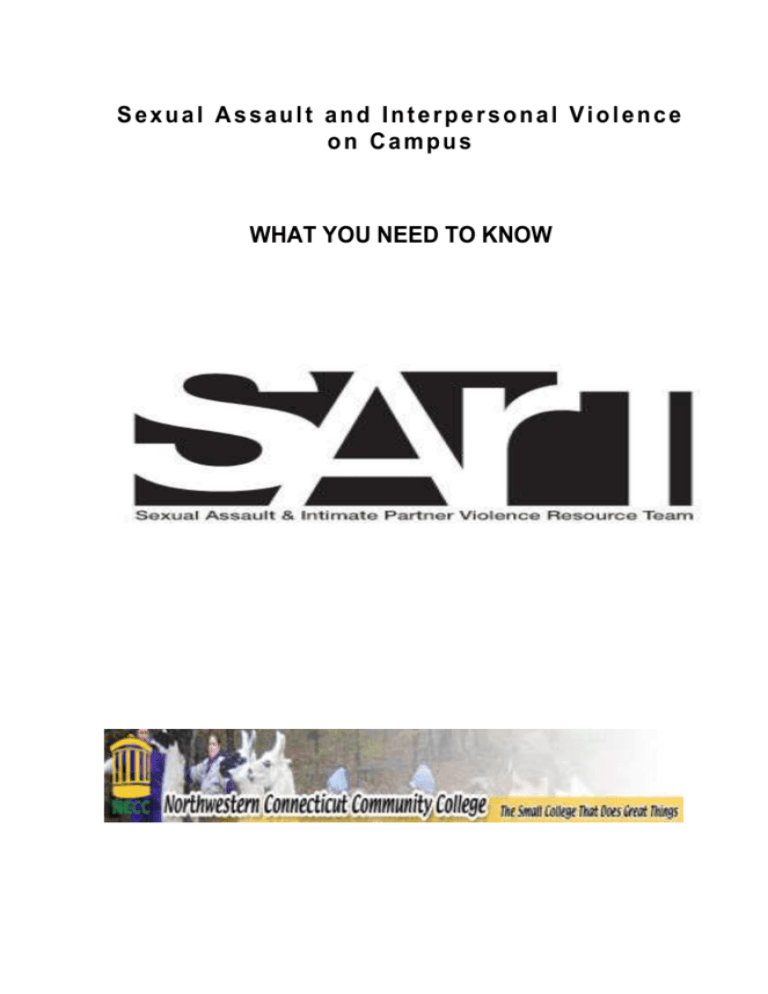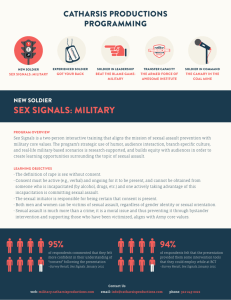
S e xu a l A s sau l t an d I n t e rp e r so n al V i o l en c e
o n Ca mp u s
WHAT YOU NEED TO KNOW
Table of Contents
UNDERSTANDING SEXUAL/INTERPERSONAL VIOLENCE .................. 1
WHAT IS SEXUAL ASSAULT? ............................................................. 1
WHAT IS STALKING? .......................................................................... 1
WHAT IS SEXUAL HARRASSMENT? ................................................... 1
WHAT IS INTERPERSONAL VIOLENCE? ............................................. 2
TYPES OF ABUSE ........................................................................... 3
CONSENT........................................................................................ 3
Consent is: ....................................................................................... 3
Consent is NOT: ............................................................................... 4
HOW CAN I HELP STOP SEXUAL ASSAULT VIOLENCE? .................... 5
Proactive Bystander Intervention ........................................................ 5
Reactive Bystander Strategies............................................................ 5
YOUR RIGHTS ..................................................................................... 6
REPORTING OR DISCLOSING SEXUAL ASSAULT, SEXUAL
HARASSMENT, DATING OR INTIMATE PARTNER VIOLENCE, OR
STALKING TO NCCC ........................................................................... 7
RESOURCES ....................................................................................... 8
PUBLIC NOTICE OF NONDISCRIMINATION ....................................... 10
UNDERSTANDING SEXUAL/INTERPERSONAL VIOLENCE
WHAT IS SEXUAL ASSAULT?
Sexual Assault is compelling by force or by threat of force the following:
sexual penetration of the vagina or anus, including by an object; oral sex;
or contact with a person’s genital area, groin, anus, inner thighs, buttocks
or breasts for the purpose of sexual gratification of the actor or for the
purpose of degrading or humiliating the victim.
Sexual assault is also intentionally subjecting another to such contact
without consent. Any person can be a victim or perpetrator.
Examples of sexual assault include: rape, attempted rape, intentional
touching without consent of a person’s genital area, groin, anus, inner
thighs, buttocks or breasts for sexual gratification or to degrade the
victim.
WHAT IS STALKING?
Stalking is any behaviors or activities occurring on more than one (1)
occasion that collectively instills fear in the victim and/or threatens her/his
safety, mental health and/or physical health. Such behaviors or activities
may include, but are not limited to, whether on or off campus, nonconsensual communications face-to-face, telephone, email, Facebook,
etc., threatening or obscene gestures, surveillance or being present
outside the victim’s classroom or workplace.
WHAT IS SEXUAL HARRASSMENT?
Sexual Harassment is a form of unlawful gender-based discrimination. It
may involve harassment of women by men, harassment of men by
women, and harassment between persons of the same sex. Sexual
harassment is defined as unwelcome gender-based verbal or physical
conduct that is sufficiently severe, persistent, or pervasive that it
unreasonably interferes with, limits or deprives someone of the ability to
participate in or benefit from the college’s educational program or
1
activities or employment benefits or opportunities. The unwelcome
behavior may be based on power differentials such as quid pro quo
harassment where submission to or rejection of unwelcome sexual
conduct by an individual is used as the basis for employment or
academic decisions, the creation of a hostile environment or retaliation.
Examples of conduct which may constitute sexual harassment include
but are not limited to:
Sexual flirtation, touching, advances or propositions
Verbal abuse of a sexual nature
Pressure to engage in sexual activity
Implied or overt threats of punitive action, a result of rejection of
sexual advances
Graphic or suggestive comments about an individual’s dress or
appearance
Use of sexually degrading words to describe an individual
Display of sexually suggestive objects, pictures or photographs
Sexual jokes
Comments based upon gender
Threats, demands or suggestions that retention of one’s
educational status is contingent upon toleration of or
acquiescence in sexual advances.
WHAT IS INTERPERSONAL VIOLENCE?
Relationship Violence may be present in dating and domestic violence,
sometimes also called intimate partner violence. It is a pattern of
behavior in which one partner uses fear and intimidation to establish
power and control over the other partner, often including the threat or use
of violence. This abuse happens when one person believes they are
entitled to control another and it may or may not include sexual assault.
Dating and domestic violence occur in straight/heterosexual
relationships, same-sex/gender relationships and in intimate
relationships that do not involve romantic feelings. Intimate partner
2
violence impacts people of all ethnicities, races, classes, abilities, and
nationalities.
Although there are some general patterns in domestic or dating violence,
there is not typical abusive behavior. To wear down and control his/her
victim, an abuser may use isolation, emotional harassment, physical
contact, intimidation or other means. The controlling behavior usually
escalates, particularly if the victim of the abuse tries to resist or leave.
TYPES OF ABUSE
In a violent relationship, behaviors that are used to maintain fear,
intimidation, and power over
another person may include threats,
intimidation, and economic abuse,
sexual abuse, taking advantage of
male privilege, or using someone’s
identity against them. These
behaviors may take the form of
physical, sexual, emotional, and
psychological violence.
CONSENT
An important concept for all of us, regardless of age, is one of consent.
Consent is the most misunderstood concept in comprehending the
issues around interpersonal violence. Learning how to talk about
consent, gain consent and refuse consent, can help clarify each person’s
responsibility to minimize the risk of unwanted sexual contact.
Consent is:
a voluntuary, sober, informed, mutual, honest and verbal
agreement
an active agreement. Consent cannot be coerced.
3
a process, which must be asked for every step of the way. If
you want to move to the next level of sexual intimacy, you
should ask!
never implied and cannot be assumed, even in the context of a
relationship. Just because you are in a relationship does not
mean that you have permission to have sex with your partner.
Consent is NOT:
If someone says no repeatedly and finally says yes
If someone is incapacitated by substances
If someone has only agreed to an earlier act
If someone says nothing
If someone is never asked for consent
If someone has been made to feel that they must say yes
If someone uses their position of power or authority to coerce or
manipulate someone into saying yes
How do you know that someone has given
consent?
The only way to know for sure if someone
has given consent, is if they tell you. It’s not
always easy to let people know that you are
not happy about something. Sometimes the
person you’re with might look like they are happy doing something, but
inside, they are not. They might not know what to say or how to tell you
that they are uncomfortable. One of the best ways to determine if
someone is uncomfortable with any situation, especially with a sexual
one, is to simply ask.
4
HOW CAN I HELP STOP SEXUAL ASSAULT VIOLENCE?
Sexual assault and interpersonal violence are complex and very real
issues on and off campus. In order to address this reality, all members
of the campus community and relevant off-campus support agencies,
must work together. Everyone has a role to play in ending sexual
violence. To prevent gender-based violence, it is important that people
are approached as potential witnesses or bystanders to behaviors
related to sexual or dating violence.
Proactive Bystander Intervention
In order to be a proactive bystander who helps prevent incidents of
sexual violence, you can…
Believe violence is unacceptable and say it out loud.
Talk openly with your friends about these issues.
Use the resources listed in this brochure to inform yourself.
Don’t laugh at sexist jokes or comments.
Empower victims to tell their stories.
Reactive Bystander Strategies
In order to be a reactive bystander who positively intervenes in instances
of sexual harrassment or violence, there are certain ways you can step
up to prevent a risky situation from
resulting in an assault.
Assume responsibility of intervening.
Don’t be afraid to get involved.
Get help from friends.
Get help from campus authorities for
support and options.
Ask the person who is in a potentially
dangerous situation if she/he wants to
leave.
5
YOUR RIGHTS
You have the right to…
Be treated with respect and dignity.
Privacy. This means you can refuse to answer any questions
about the sexual assault, your sexual orientation, your sexual
history (including HIV status), and your medical history.
Be notified of existing campus and community based medical
counseling, mental health and victims of sexual assault
resources, whether or not the crime is formally reported to
campus or civil authorities.
A timely disposition if reporting an incident to the College.
Be notified of the outcome of the College’s sexual assault
conduct proceedings against the accused.
Have conversations with a member of the Sexual Assault
Resource Team (SART).
Have access to local sexual assault crisis service center.
Have access to a local domestic violence agency.
Have a counselor/advocate to accompany you to medical and
legal proceedings.
Decide whether or not you want the police to investigage the
assault.
Request that someone you are comfortable with stay with you in
the medical examination room.
Ask questions and get answers regarding any tests, exams,
medications, treatments or police reports.
Not be judged on your race, age, class, marital status, gender or
sexual orientation.
Be considered a victim/survivor of sexual assault, regardless of
the offender’s relationship to you.
Additional information regarding sexual misconduct and campus policies
is available at www.nwcc.commnet.edu and on postings throughout the
campus.
6
REPORTING OR DISCLOSING SEXUAL ASSAULT, SEXUAL
HARASSMENT, DATING OR INTIMATE PARTNER VIOLENCE, OR
STALKING TO NCCC
1. Report incident to Dr. Patricia Bouffard, Dean of Academic &
Student Affairs, 860.738.6319 pbouffard@nwcc.edu and/or Title
IX Coordinator, Dr. Ruth E. Gonzalez, Director of Student
Development, 860.738.6315 rgonzalez@nwcc.edu
2. Depending on the nature of the complaint and the desires of the
complainant, the College official to whom the complaint has
been made may attempt to resolve the complaint informally. If
informal resolution is not possible or appropriate, a written
complaint should be filed in accordance with the the Student
Grievance Procedure.
3. Written complaint should be filed within thirty (30) days of the
date the grievant knew or should have known of the alledged
harrassment. A written complaint will be treated in the manner
prescribed by this policy if filed within 180 days of the date the
student knew or should have known of the alleged harassment.
4. When a formal complaint of sexual harassment is received, the
College will investigate. The rights of all persons involved in the
investigation shall be respected and every effort will be made to
protect the confidentiality of both the alleged victim and the
alleged harasser. However, complete anonymity cannot be
assured, given the College’s obligation under law to investigate
and take appropriate action in all cases of sexual harasment.
5. A request for review by the College President may be made
within three (3) business days of receiving notice of
determination.
6. If you witness an assualt on campus, immediately call 911.
7
RESOURCES
NCCC SART:
Ruth E. Gonzalez, Ph.D.
860-738-6315 GW 220
Susan Berg
860-738-6342 GW 223
Kathleen Chapman
860-738-6344 GW 110
Michael Emanuel
860-738-6389 FH 308
Gary Greco –CEDHH
860-469-3138 (VP) FH 101
860-738-6397 (V)
Jane O’Grady
860-738-6393 FX 212
Robin Orlomoski
860-738-6416 Business 201
Savannah Schmitt
Student Representative
Jacob Wujcik
Student Representative
Patricia Bouffard, Dean
of Academic & Student Affairs
860-738-6319 FH 103
Confidential Community Members:
Susan B. Anthony Project
860-482-7133 Hotline
www.sbaproject.org
Charlotte Hungerford Hospital
860-496-6666
CT Sexual Assault Crisis Services
888-999-5545
888-568-8332
Winsted Police Department
860-379-2721
Torrington Police Department
860-489-2000
CT State Police Dispatch (Troop L)
860-626-7900
CT State Police Dispatch (Troop B)
860-542-5249
8
9
PUBLIC NOTICE OF NONDISCRIMINATION
Northwestern Connecticut Community College does not discriminate on
the basis of race, color, religious creed, age, sex, national origin, marital
status, ancestry, present or past history of mental disorder, learning
disability or physical disability, veteran status, sexual orientation, gender
identity and expression, genetic information or criminal record in its
programs and activities.
The following person has been designated to handle inquiries regarding
the non-discrimination policies: Dr. Ruth E. Gonzalez, Director of Student
Development, (Title IX and Section 504/ADA Coordinator) Northwestern
Connecticut Community College, Park Place East, Winsted, CT 06098,
Green Woods Hall, Room 207 (860) 738-6315, rgonzalez@nwcc.edu.
NORTHWESTERN CONNECTICUT COMMUNITY COLLEGE •
Park Place East, Winsted, CT 06098 • Phone: 860-738-6300
www.nwcc.commnet.edu
10






